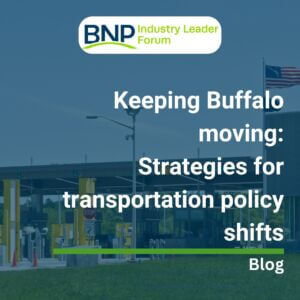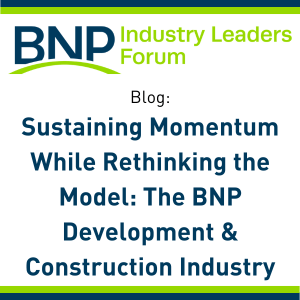Keeping Buffalo moving: Strategies for transportation policy shifts
The Partnership
March 25, 2025
Blog Categories

Buffalo Niagara sits at the center of one of North America’s busiest trade corridors. As the third largest bi-national metro region, with a population of approximately 9 million, our location offers a strategic advantage but also comes with responsibility.
On Mar. 20, the Buffalo Niagara Partnership convened transportation and logistics leaders for the 2025 Transportation Industry Leaders Forum (ILF) to discuss how the sector can navigate new sustainability demands, policy shifts, and infrastructure needs to keep the region—and its economy—moving forward across roadways, borders, and communities.
The Challenge: A sustainable path for cross-border trade and mobility
Panelists and attendees tackled sector-defining questions:



 Expert insights from transportation leaders
Expert insights from transportation leaders
The session featured a dynamic panel representing freight, public transit, regional planning, EV infrastructure, and sustainable business:
- Meaghan Phillips, Director of Freight Brokerage/3PL, Speed Global Services
- Whitney Skeans, Lead Program Manager, Electric Vehicles – NY, National Grid
- Darren Kempner, Director of Grants & Development, Niagara Frontier Transportation Authority (NFTA)
- Kelly Dixon, Principal Planner, GBNRTC
- Anna Attea, Executive Director, Western New York Sustainable Business Roundtable
Their insights addressed the potential impact of federal trade policies, like tariffs that could disrupt Canadian imports, which is a critical issue for our binational economy. Panelists also emphasized the need for ongoing investment in EV charging infrastructure, noting the momentum across public and private sectors to meet growing demand.
Additionally, local planning leaders highlighted route optimization as both a sustainability and efficiency tool, especially as supply chains adapt to new expectations around speed and environmental impact.
 Why It Matters
Why It Matters
Buffalo Niagara’s economy relies on efficient, cross-border transportation. As regulations evolve and sustainability becomes non-negotiable, our region must embrace innovation—from freight optimization to electrified fleets to smarter policy alignment.
The BNP’s ILF series continues to serve as a space for collaboration, foresight, and action across sectors. As 2025 progresses, we’ll explore how other key industries—from finance to small business—are rising to meet their own sustainability challenges.


Related Posts
Cost of Health Care Inequity Is a Major Economic Drain on Regions
There’s a growing recognition that societal and socioeconomic factors affect the health of individuals. Known as Social Determinants of Health, these factors influence health outcomes, such as socioeconomic status, education, neighborhood and physical environment, employment, and access to health care. T
Navigating the Road Ahead: The BNP Transportation & Logistics Industry Leaders Forum
Exploring the Need for Regional Transportation Network Improvements & Advancements in Global Logistics
Navigating the Future of Healthcare: The BNP Healthcare & Human Services Industry Leaders Forum
How can Buffalo Niagara health and human service providers simultaneously navigate fiscal difficulties, changing regulations and talent challenges?
Sustaining Momentum While Rethinking the Model: The BNP Development & Construction Industry Leaders Forum
How can Buffalo Niagara developers and builders compete for tenants, talent and transformative projects while markets and regulations constantly change?

 Expert insights from transportation leaders
Expert insights from transportation leaders Why It Matters
Why It Matters



